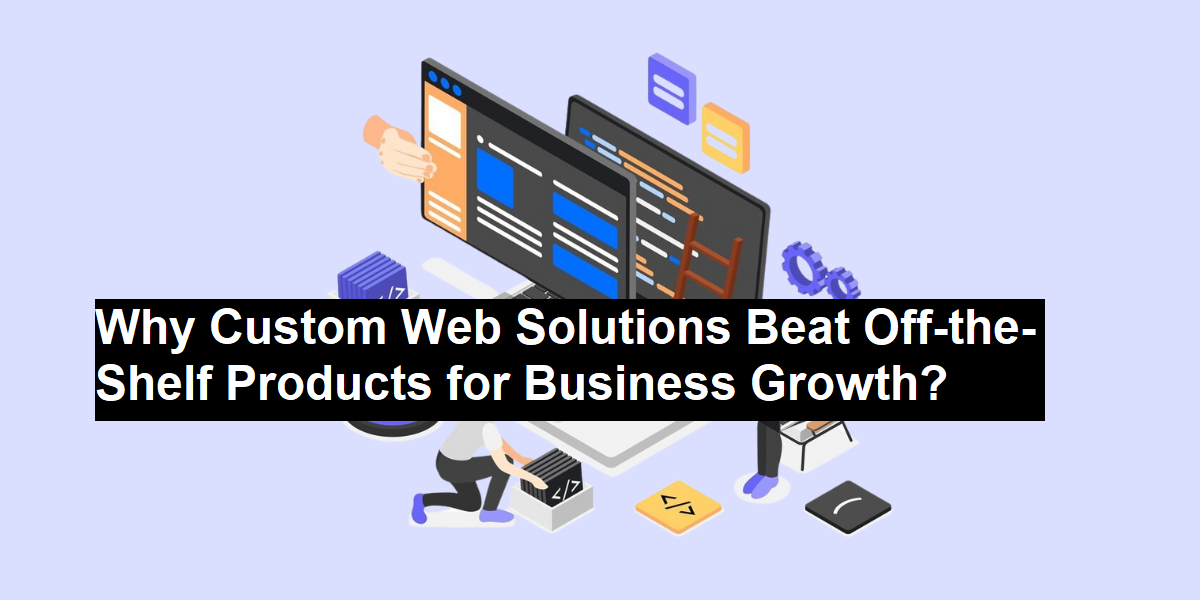Every business is a unique ecosystem of challenges, processes, and growth opportunities. That’s why, while off-the-shelf solutions might seem convenient, they often become barriers to scale – forcing your business to adapt to the software rather than the other way around.
The Problems with “One-Size-Fits-All”
Off-the-shelf solutions are like buying a suit off the rack—it might look fine, but it’ll never feel like it’s made for you. And as your business grows, those quick fixes turn into big headaches:
- Wasted Time: Adapting your processes to software that wasn’t designed for you.
- Limited Growth: Hitting a wall because your tools can’t scale with your business.
- Integration Hassles: Struggling to connect systems, leading to inefficiencies and frustration.
- Hidden Costs: Paying for customizations, upgrades, or features you never use.
Think Bigger with Custom Development
Your software should reflect your ambition. It’s not just about solving today’s problems—it’s about creating the tools you’ll need tomorrow. A custom web solution gives you the freedom to think beyond what’s possible and build digital experiences that truly fuel your growth.
After all, why settle for “good enough” when you can have “perfect for us”?
Read: 4 Fun Activities for An Alcohol-free Visit To Warwickshire
Custom vs. Off-the-Shelf: Core Differences
| Parameters | Custom Web Solutions | Off-the-Shelf Software |
| Definition | Tailored solutions built to address specific workflows, industry challenges, and scalability needs. | Prebuilt software designed to cater to generic business requirements. |
| Cost | Higher initial custom web app development cost, but almost nill recurring licensing fees. Ideal for businesses planning for long-term ROI. | Lower upfront cost, but recurring subscription/renewal fees that can accumulate over time. |
| Development Time | Requires time to plan, design, and build solutions unique to your business. Hire web application developers to optimize delivery schedules. | Ready-to-use with minimal setup time, suitable for businesses needing immediate solutions. |
| Scalability | Scales seamlessly with business growth; offers flexibility to accommodate future changes or integrations. Perfect for industries with rapid scaling needs. | Limited scalability; upgrades often require significant additional investment or switching systems entirely. |
| Customization | Fully tailored to meet your business model. Suitable for niche industries needing unique processes like custom quoting, analytics, or inventory management. | Limited customization; functionality often requires adapting workflows to the software rather than vice versa. |
| Integration | Designed for seamless integration with existing tools, CRMs, or proprietary systems. Hire web developers to eliminate compatibility issues. | May require expensive third-party tools or extensive workarounds for integration. |
| Support & Maintenance | Dedicated ongoing support with direct access to development teams. You can hire web developers to get timely upgrades and fixes tailored to your needs. | Vendor-driven updates that may not align with your operational priorities or timing. |
| Security | Industry-specific security features that address compliance requirements and data protection laws. Critical for finance, healthcare, and e-commerce sectors. | Standardized security measures that may leave gaps in industry-specific protection. |
| Risk | Higher upfront investment, but ownership of intellectual property ensures independence from third-party vendors. | Low initial risk, but long-term dependence on vendor reliability and license terms. |
Cost Comparison: Investment vs. ROI
Deciding between custom web solutions and off-the-shelf software comes down to balancing costs with long-term benefits. Here’s an inclusive breakdown to guide your choice:
1. Initial Investment
- Custom Web Solutions: The upfront custom web app development cost gives you tailored features, seamless integrations, and ownership in return. While higher initially, this cost avoids recurring fees and delivers long-term value.
- Example: A logistics startup invested in a custom tracking system. Despite the higher cost, it reduced delivery delays by 30%, saving significant operational costs in a year.
- Off-the-Shelf Software: Offers lower initial costs, making it appealing for businesses needing quick deployment. However, these solutions often require compromise on features.
- Example: A small retailer used an off-the-shelf inventory tool. While affordable, it couldn’t scale with their growing operations, leading to inefficiencies.
2. Long-Term Costs
- Custom Web Solutions: Maintenance costs are predictable and typically lower over time. Since you own the solution, you avoid vendor dependency and recurring subscription fees.
- Off-the-Shelf Software: Costs accumulate through monthly or annual subscriptions. Upgrades, additional features, or user licenses can significantly increase the total cost of ownership.
3. Scalability and ROI
- Custom Web Solutions: Designed to scale effortlessly with your growth. Whether adding advanced analytics, AI, or IoT integrations, custom software evolves with your needs. This results in a high ROI over time.
- Example: An online learning platform implemented a custom web app to personalize courses for users. This led to a 40% increase in user engagement and revenue.
- Off-the-Shelf Software: Scalability is limited. Expanding features or users often requires upgrading to premium versions, potentially leading to disruption and higher costs.
Benefits and Challenges of Each Approach
Choosing between custom web application development services and off-the-shelf solutions depends on your business needs, scalability, and long-term goals. Below are the advantages and limitations of each approach:
Custom Web Solutions
Benefits:
- Tailored to your Needs: Built specifically to address your business processes, delivering unique features and seamless integration.
- Example: A logistics firm developed custom software for real-time fleet tracking, reducing delivery times by 25%.
- Scalable and Future-Proof: Easily adapts to business growth or technological advancements, ensuring relevance over time.
- Higher ROI: Eliminates licensing fees and aligns with business goals, optimizing workflows and reducing operational inefficiencies.
- Enhanced Security: Provides advanced, industry-specific security measures, ensuring compliance with regulations like GDPR or HIPAA.
- Full Control: Ownership ensures you dictate updates, integrations, and scalability.
Challenges:
- High Initial Investment: Upfront costs can be significant, but long-term savings often outweigh the expense.
- Longer Development Time: Requires months to design and build, which may not suit businesses needing immediate solutions.
- Maintenance Responsibility: Requires dedicated resources for updates and troubleshooting.
Off-the-Shelf Software
Benefits:
- Lower Upfront Cost: Ideal for startups or businesses with tight budgets.
- Quick Deployment: Ready to use, making it suitable for businesses with urgent needs.
- Pre-Tested Features: Reliable functionality with user feedback already incorporated.
- Example: A retail business adopted off-the-shelf POS software, enabling operations to start within days.
- Ongoing Vendor Support: Regular updates and troubleshooting from the provider.
Challenges:
- Limited Customization: Often requires businesses to adapt workflows to fit the software.
- Scalability Issues: Ready-made solutions struggle to accommodate growth or advanced features without expensive upgrades.
- Dependency on Vendor: Lack of control over updates or feature roadmaps can lead to inefficiencies.
- Higher Long-Term Costs: Recurring subscription fees and upgrade costs can exceed custom software investment over time.
Real-World Use Cases: Custom vs. Off-the-Shelf
Healthcare
- Custom Software: Meets HIPAA, GDPR, or region-specific compliance while integrating seamlessly with EHR systems.
- Off-the-Shelf: Suitable for smaller clinics with basic needs, but less reliable for unique data workflows or regulations.
E-Commerce Startups
- Custom Software: Tailored for personalized shopping experiences, AI-based product recommendations, and customer segmentation.
- Off-the-Shelf: Quick setup with ready integrations like Shopify but limited for businesses aiming for niche branding.
FinTech Enterprises
- Custom Software: Advanced algorithms for risk modeling, fraud detection, and compliance with evolving financial standards.
- Off-the-Shelf: Easier to adopt but lacks flexibility in adapting to innovative, fast-paced financial markets.
Making the Right Choice: A Decision Framework
Choosing between custom web solutions and off-the-shelf software can be simplified by evaluating your business needs and long-term goals. Here’s a clear checklist to guide your decision:
1. Scalability
- Custom Web Solutions: Perfect for businesses expecting growth, these solutions evolve with your needs, incorporating advanced features like AI or IoT.
- Example: A logistics company expanded its custom web app by integrating predictive analytics, cutting operational costs as it scaled.
- Off-the-Shelf Software: Suitable for businesses with stable needs, but often struggles to keep up with complex growth requirements.
- Ask Yourself: Will your software need to adapt to significant growth or evolving demands?
2. Integration
- Custom Web Solutions: Designed to integrate effortlessly with existing systems, streamlining workflows and boosting productivity.
- Example: A healthcare startup implemented a custom solution for seamless CRM integration, eliminating data silos and enhancing patient care.
- Off-the-Shelf Software: This may require third-party tools or custom bridges, increasing complexity and costs.
- Ask Yourself: Does your software need to work smoothly with existing tools and platforms?
3. Budget
- Custom Web Solutions: While the initial custom web app development cost is higher, it eliminates recurring subscription fees. The predictable maintenance expenses ensure long-term savings and ownership.
- Off-the-Shelf Software: Low upfront costs but comes with ongoing subscription fees and potential charges for additional features, which can add up over time.
- Ask Yourself: Are you focused on short-term savings, or do you prioritize long-term ROI?
4. Customization Needs
- Custom Web Solutions: Tailored to meet specific workflows, compliance requirements, or industry demands.
- Example: A retail business developed a custom inventory tracking app, increasing sales by 20% through improved stock management.
- Off-the-Shelf Software: Limited customization; often forces businesses to adapt processes to fit the software rather than the other way around.
- Ask Yourself: Do you need software tailored to your business’s unique processes?
5. Time-to-Market
- Custom Web Solutions: Development takes longer but results in a unique solution perfectly aligned with your goals. Hiring the right team can optimize timelines.
- Off-the-Shelf Software: Quick to deploy, making it ideal for businesses needing an immediate operational fix.
- Ask Yourself: How critical is the speed of deployment for your business?
Future Trends in Software Solutions
The future of the software industry is driven by innovation and flexibility. Businesses must embrace these trends for success:
- AI Customization: AI enhances user experiences with personalization and predictive analytics, making software smarter and more efficient.
- Modular Solutions: Flexible systems allow businesses to add or replace features easily, cutting costs and adapting to change quickly.
- Hybrid Approaches: Combining custom web solutions with off-the-shelf components speeds up deployment while ensuring essential features are tailored.
- Low-Code Platforms: Simplify development, enabling quicker prototypes and empowering teams to innovate without deep technical skills.
Adopting these trends helps businesses stay agile, competitive, and ready for the future. Hire web application developers to build scalable, innovative solutions tailored to your needs.
Conclusion: Aligning Software Decisions with Growth Goals
Strategic software selection acts as a foundation for long-term business success. Whether you choose off-the-shelf software or invest in custom web application development services, the right decision aligns with your unique growth trajectory.
Custom Web Solutions: A Future-Proof Investment
Custom software offers flexibility and scalability, adapting to your evolving needs. Businesses requiring tailored workflows or unique integrations often find the initial custom web app development cost justified by long-term gains in efficiency, ROI, and competitive advantage.
- Example: A property management company implemented a custom SaaS platform to automate tenant interactions, cutting operational time by 60% and reducing service charges by 4%.
Off-the-Shelf Software: Quick and Accessible
Prebuilt solutions serve as an efficient starting point for businesses with limited budgets or immediate needs. However, their limitations in customization and scalability may hinder future growth, making them less suitable for organizations with complex or evolving requirements.
Key Takeaway
Align your software decisions with your growth goals. For businesses seeking agility and long-term value, custom web solutions provide a tailored path to success. If your needs are basic and short-term, off-the-shelf software may suffice, but always weigh its constraints.
Pro Tip: Partner with professionals offering custom web application development services to build a solution that evolves with your business. This ensures your software remains an asset, not a limitation, as you scale.
Author’s Bio:
Nathan Smith is a Technical Writer at TechnoScore with extensive knowledge in software documentation, API guides, and user experience. Nathan’s expertise covers Application Development, DevOps, and Staff Augmentation (Hire mobile app developers, hire WordPress developers, and hire full stack developers etc.).


